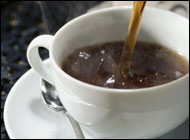Coffee Drinkers: Fruit Flies Have Something to Tell You About Caffeine
In their hunt for genes and proteins that explain how animals discern bitter from sweet, a team of John Hopkins researchers began by testing whether mutant fruit flies prefer eating sugar over sugar laced with caffeine. Using a simple behavioral test, the researchers discovered that a single protein missing from the fly-equivalent of our taste buds caused them to ignore caffeine’s taste and consume the caffeine as if it were not there.
“No, you won’t see jittery Drosophila flitting past your bananas to slurp your morning java anytime soon,” says Craig Montell, Ph.D., a professor of biological chemistry in the Institute of Basic Biomedical Sciences at Hopkins. “The bottom line is that our mutant flies willingly drink caffeine-laced liquids and foods because they can’t taste its bitterness - their taste receptor cells don’t detect it.”
The Hopkins flies, genetically mutated to lack a certain taste receptor protein, have been the focus of studies to sort out how animals taste and why we like the taste of some things but are turned off by the taste of others.
By color-coding sweet and bitter substances eaten by fruit flies and examining the coloring that shows up in their translucent bellies, the Hopkins team hoped to learn whether flies missing a specific “taste-receptor” protein changed their taste preferences.
“Normally,” Montell explains, “when given the choice between sweet and bitter substances, flies avoid caffeine and other bitter-tasting chemicals. But flies missing this particular taste-receptor protein, called Gr66a, consume caffeine because their taste-receptor cells don’t fire in response to it.”
The discovery, which is the first ever example of a protein required for both caffeine tasting and caffeine-induced behavior, will be published Sept. 19 in Current Biology. 
For the study, Montell and his colleagues kept 50 fruit flies away from food overnight and for breakfast gave the starved flies 90 minutes to eat as much as they wanted of either or both of two concoctions: a blue-colored mixture of sugar and agar and a red-colored mixture of caffeine, sugar and agar. The researchers then flipped the flies onto their backs and looked at the color of their bellies to see what they ate - blue indicating a preference for eating sugar, red indicating a preference for bitter caffeine, and purple indicating no preference.
Flies missing the critical taste receptor protein Gr66a consumed the bitter caffeine solution to the same extent as the sugar-only solution. Montell and colleagues conclude that Gr66a is crucial for the normal caffeine avoidance behavior and without it, flies are seemingly indifferent to the bitter taste.
The researchers went on to examine whether this indifference to bitter was due to the taste nerves on the fly’s “tongue” or some malfunction in the fly’s brain. Chemical stimulants trigger taste receptor cells to send an electrical current to the brain where the information is processed and often leads to a change in behavior, such as the decision to eat or avoid.
With fine tools, the research team recorded electrical currents in those cells known to contain the Gr66a caffeine taste receptor in the fly’s equivalent of the taste buds - dubbed the taste bristles.
Applying sugar to the taste bristles of normal flies, or to mutant flies missing the Gr66a protein, causes the neurons to produce electrical current “spikes” at a frequency of about 20 spikes per second. Other bitter compounds like quinine generated electrical current spikes at about the same frequency in the mutants.
Only flies missing the Gr66a taste receptor protein were unable to generate any current spikes when given caffeine. “This is a clear demonstration that Gr66a is functioning in the taste receptor cells and is not a ‘general sensor’ for bitter compounds, but is required more specifically for the caffeine response,” says Montell.
“This indicates that flies have different receptors for the response to other types of bitter compounds,” he says.
“We also tested whether the flies avoided the related bitter compounds found in tea and cocoa - chocolate - and found that Gr66a also is required for the response to the compound in tea, but not for the one in chocolate,” he says.
Fruit flies often are used as experimental organisms because they grow quickly and are easy to manipulate genetically. Now that Montell and his colleagues have a mutant fly that is unable to taste caffeine, they hope to further examine the other genes and molecules involved in the caffeine response and better understand the biochemistry behind caffeine-induced behavior in other organisms, namely humans.
The researchers were funded by the Polycystic Kidney Disease Foundation and the National Institute of Deafness and Communicative Disorders of the National Institutes of Health.
Authors on this paper: Seok Jun Moon, Michael Ko"ttgen, Yuchen Jiao, Hong Xu and Montell, all of Hopkins.
Revision date: July 3, 2011
Last revised: by Tatiana Kuznetsova, D.M.D.